-
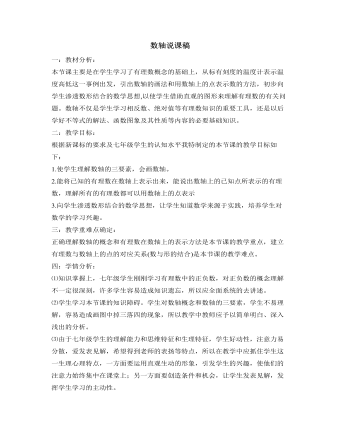
北师大初中数学七年级上册数轴说课稿
(五)、反馈矫正,注重参与: 为巩固本节的教学重点让学生独立完成: 1、课本23页练习1、2 2、课本23页3题的(给全体学生以示范性让一个同学板书) 为向学生进一步渗透数形结合的思想让学生讨论: 3、数轴上的点P与表示有理数3的点A距离是2, (1)试确定点P表示的有理数; (2)将A向右移动2个单位到B点,点B表示的有理数是多少? (3)再由B点向左移动9个单位到C点,则C点表示的有理数是多少? 先让学生通过小组讨论得出结果,通过以上练习使学生在掌握知识的基础上达到灵活运用,形成一定的能力。 (六)、归纳小结,强化思想: 根据学生的特点,师生共同小结: 1、为了巩固本节课的教学重点提问:你知道什么是数轴吗?你会画数轴吗?这节课你学会了用什么来表示有理数? 2、数轴上,会不会有两个点表示同一个有理数?会不会有一个点表示两个不同的有理数? 让学生牢固掌握一个有理数只对应数轴上的一个点,并能说出数轴上已知点所表示的有理数。
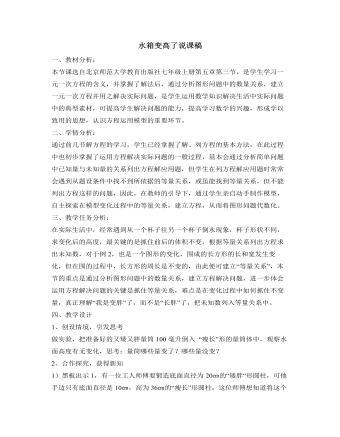
北师大初中数学七年级上册水箱变高了说课稿
一、教材分析:本节课选自北京师范大学教育出版社七年级上册第五章第三节,是学生学习一元一次方程的含义,并掌握了解法后,通过分析图形问题中的数量关系,建立一元一次方程并用之解决实际问题,是学生运用数学知识解决生活中实际问题中的典型素材,可提高学生解决问题的能力,提高学习数学的兴趣,形成学以致用的思想,认识方程运用模型的重要环节。二、学情分析:通过前几节解方程的学习,学生已经掌握了解、列方程的基本方法,在此过程中也初步掌握了运用方程解决实际问题的一般过程,基本会通过分析简单问题中已知量与未知量的关系列出方程解应用题,但学生在列方程解应用题时常常会遇到从题设条件中找不到所依据的等量关系,或虽能找到等量关系,但不能列出方程这样的问题,因此,在教师的引导下,通过学生亲自动手制作模型,自主探索在模型变化过程中的等量关系,建立方程,从而将图形问题代数化。
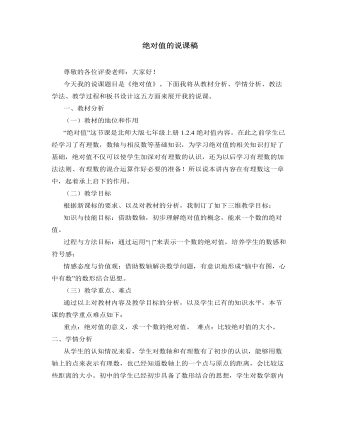
北师大初中数学七年级上册绝对值的说课稿
(三)学以致用,巩固新知为巩固本节的教学重点我再次给出三道问题: 1)绝对值是7的数有几个?各是什么?有没有绝对值是-2的数?2)绝对值是0的数有几个?各是什么? 3)绝对值小于3的整数一共有多少个?先让学生通过小组讨论得出结果,通过以上练习使学生在掌握知识的基础上达到灵活运用,形成一定的能力。(四)总结归纳,知识升华小结时我也将充分发挥学生学习的主动性,发挥教师在教学的启发引导作用,和学生一起合作把本节课所学的内容做一个小结。(五)布置作业,拓展新知布置作业不是目的,目的是使学生能够更好地掌握并运用本节课的内容。所以我会布置这样一个作业:请学生回家在父母的帮助下,找出南方和北方各三个城市的温度,并比较这些温度的大小,并写出每个温度的绝对值进行比较
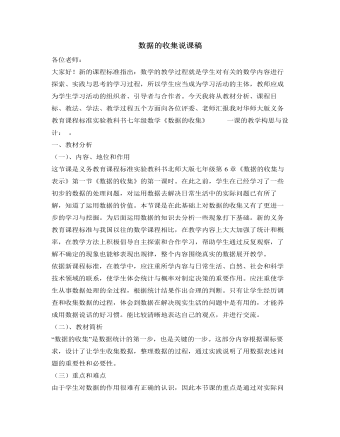
北师大初中数学七年级上册数据的收集说课稿
一、教材分析(一)、内容、地位和作用这节课是义务教育课程标准实验教科书北师大版七年级第6章《数据的收集与表示》第一节《数据的收集》的第一课时。在此之前,学生在已经学习了一些初步的数据的处理问题,对运用数据去解决日常生活中的实际问题已有所了解,知道了运用数据的价值。本节课是在此基础上对数据的收集又有了更进一步的学习与挖掘。为后面运用数据的知识去分析一些现象打下基础。新的义务教育课程标准与我国以往的数学课程相比,在教学内容上大大加强了统计和概率,在教学方法上积极倡导自主探索和合作学习,帮助学生通过反复观察,了解不确定的现象也能够表现出规律,整个内容围绕真实的数据展开教学。依据新课程标准,在教学中,应注重所学内容与日常生活、自然、社会和科学技术领域的联系,使学生体会统计与概率对制定决策的重要作用。
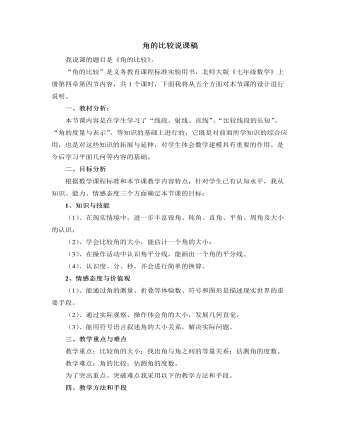
北师大初中数学七年级上册角的比较说课稿
最后我引导学生观察自己手中的量角器引导学生在测量的时候有时用度的单位还不够就必须用到比度还小的单位分和秒,进而明白度分秒之间的转换关系,并且引导学生对比和度分秒进制一样的还有时间。从而进入到例题2的讲解。接下来让学生通过随堂练习来加强和巩固本节课的内容。提高学生对本节课知识的系统综合。(四)归纳总结。小结主要由学生完成,我作出适当的补充。最后总结角的比较表方法及估测和某些角之间的等量关系的书写基本的几何语句并能根据语句画出几何图形。(五)布置作业通过作业及时了解学生学习效果,调整教学安排。使学生通过独立思考,自我评价学习效果;学会反思,发现问题;并试着通过阅读教材、查找资料或与同伴交流解决问题。
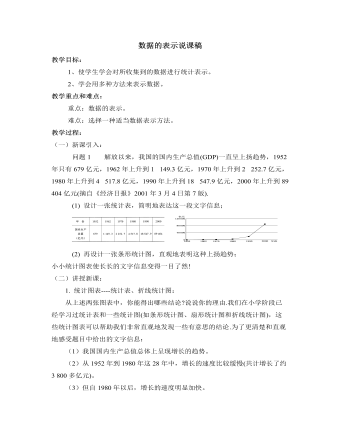
北师大初中数学七年级上册数据的表示说课稿
(1) 这28天中属于“重度染污”、“中度污染”、“轻度污染”、“良”和“优”的天数各有几天?出现的频率各是多少?请用一张统计表来表示;(3) 从你作的统计图表中,你得到哪些结论?说说你的理由.(三)课堂小结:本节课学习了用统计来直观来表示数据,并从统计图中发现数据间的联系。整理数据——制统计表1、从资料给出的许多数据中选取相关数据进行整理;2、标目分成横、纵两种(允许不同分法);3、把数据放入相应位置。为了更清晰地用统计表展示与描绘数据,统计表必须有规范的结构:标题(统计表的名称)标目(如“国家”、“届数”…)数据、必要的说明(数据的单位、制表日期等)折线统计图的步骤:(1)写出统计图名称;(2)画出横、纵两条互相垂直的数轴(有时不画箭头),分别表示两个标目的数据;(3)根据横、纵各个方向上的各对对应的标目数据画点;(4)用线段把每相邻两点连接起来。
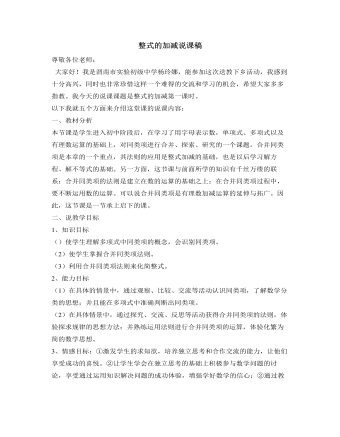
北师大初中数学七年级上册整式的加减说课稿
通过有针对性的练习,巩固所学,拓展知识,形成应用能力。本环节主要是针对学生对本节内容的掌握程度进行检测反馈。学生在经过自学、置疑、解疑、教师点拨后作一套本节的检测题。做完后,教师或学生给出答案,并给予简单解析。教师对检测成绩做以简单的统计,了解本节课的学习效果。检测题必须精心设计与安排,因为学生在做经过精心安排的检测题时,不仅在积极地掌握数学知识,而且能获得进行创造性思维的能力。要充分发挥检测题的功能,设计检测题时应由浅入深、难易适当、逐步提高、突出重点与关键、注意题型的搭配。在试题设计上,应将知识、素质、能力的考查统一起来,既有知识性、分析性题目,又有应用性、直觉形象性题目。提高创新性题型的比重和难度,少问“是什么”,多问“为什么”、“对某些问题,你以为如何”等,增强答案的发散性。
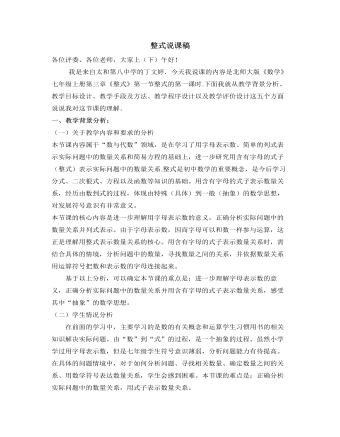
北师大初中数学七年级上册整式说课稿
按此规律,第n个式子是 。师生活动:学生通过观察,分析,归纳发现规律,并用含字母的式子表示一般结论。设计意图:进一步理解字母表示数的意义,理解用含有字母的数学式子表示实际问题中的数量关系的简洁性、必要性和一般性。(四)巩固提升问题:你能给以上这些式子赋予新的含义吗?师生活动:教师举例说明比如:如果p表示我们班的人数,我们班80%的同学喜欢上数学课,那么0.8p 就可以表示我们班喜欢数学课的人数。学生思考、交流后发言五、练习检测(1)5箱苹果重m kg,每箱重 kg ;(2)一个数比a的 倍小5,则这个数为 ;(3)全校学生总数是x,其中女生占总数52%,则女生人数是 ,男生人数是 ;(4)某校前年购买计算机 x 台,去年购买数量是前年的2倍,今年购买数量又是去年的2倍,则学校三年共购买计算机 台;(5)某班有a名学生,现把一批图书分给全班学生阅读,如果每人分4本,还缺25本,则这批图书共 本;(6)一个两位数,十位上的数字为a,个位上的数字b,则这个两位数为 .师生活动:学生板演,师生共同评价总结注意(5)带分数化假分数设计意图:进一步提高用含有字母的式子表示实际问题中的数量关系的能力。
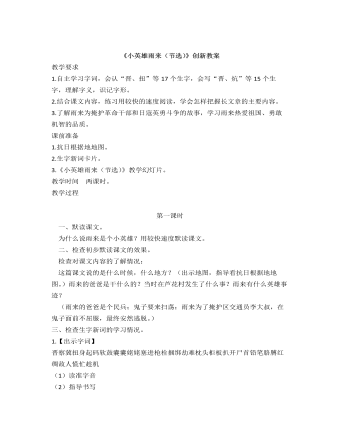
部编人教版四年级下册《小英雄雨来》创新教案
(二)提问:夜校的学习条件怎样?雨来在夜校里受到什么教育?默读第二段。指导朗读:“我们是中国人,我们爱自己的祖国。”“我们——是——中国人,我们——爱——自己的——祖国。”讨论段意和小标题。(段意:雨来上夜校,受到爱国主义教育。)(小标题:“雨来上夜校。”)(三)学习第三段。默读课文,提问:这段主要说了几层意思?学生默读课文,小组交流,展示如下:(两层意思:第一层从“有一天”至“只从街上传来一两声狗叫”,主要写鬼子开始扫荡了;第二层从“第二天”至这段结束,主要写雨来为掩护交通员李大叔,被鬼子捆绑起来了。)指导朗读第二层。重点朗读:“他抬头一看,是李大叔。”“咦!这是什么时候挖的洞呢?”“把缸搬回原地方。你就快到别的院里去,对谁也不许说。”讨论段意和小标题。段意:(雨来为掩护交通员李大叔,被鬼子捆绑起来了。)(小标题:“雨来掩护李大叔”。)
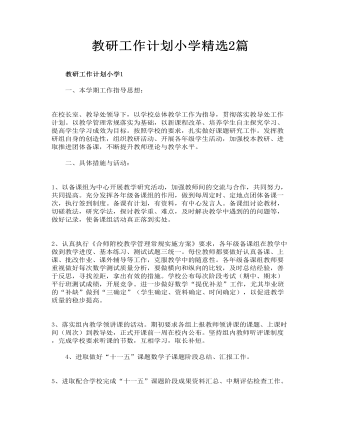
教研工作计划小学精选2篇
1、以备课组为中心开展教学研究活动,加强教师间的交流与合作,共同努力,共同提高。充分发挥各年级备课组的作用,做到每周定时、定地点团体备课一次,执行签到制度。备课有计划,有资料,有中心发言人。备课组讨论教材,切磋教法,研究学法,探讨教学重、难点,及时解决教学中遇到的的问题等,做好记录,使备课组活动真正落到实处。
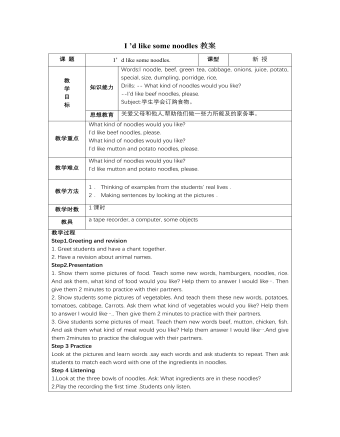
人教版新目标初中英语七年级下册I ’d like some noodles教案
教学过程Step 1: warming-up Sing a song---------“food and drink” Step 2: Revision1 Dictation2 Revise: What kind of noodles would you like?I’d like …What size bowl of noodles would you like?I’d like…Step 3: Presentation1 show pictures of food, ask students say the words.2 Students read the newspaper ad in 3a. Fill in blanks with words in the box. Then read the ad together, the teacher explains some difficult language points.3 Check the answers Step 4 PracticeAsk students to finish 3b in the same way according to 3a. Students read the short passage and fill in the blanks .At last, check the answers.Step 5 productionAsk students to write their own ad for dumplings, noodles, drinks, and other foods they know. Then ask students to read their partner’s ad. Then order food and drink from their partner.Step 6 Home workGroup work – make an ad about “food and drink”
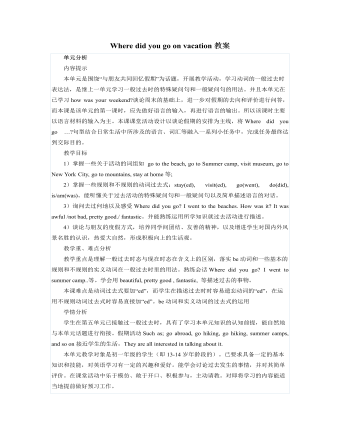
人教版新目标初中英语七年级下册Where did you go on vacation教案
句型: Where did you go on vacation? I went to summer camp.Did she go to Central Park?Yes,she did.No, she didn’t语法:一般过去时特殊疑问句、一般疑问句及肯、否定回答。课时安排4课时第一课时:Section A:la,1b,lc,2a,2b,2c 第二课时:Section A:3a,3b,4第三课时:Section B:1,2a,2b,2c第四课时:Section B:3a,3b,3c,4 and Self Check第一课时教学目标掌握描写假期生活的形容词。假期里自己所做事情的简单表达。谈论假期做的事情及当时情况。谈论假期时旅游的天气,旅游者以及食物等。教学过程一、导入播放一首英文歌曲:Let’s travel 说明:通过让学生听节奏欢快迪斯尼英语歌曲Let’s travel.引入本节课谈论的话题vacation and travel. 让歌曲使学生的思维活跃,增强课堂气氛,激发学生提高学习英语的兴趣。T:How is the trip ?Ss : It’s pretty good/ happy/exciting /relaxing/busy/dangerous/ fantastic说明:这个问题是为了操练形容词。建议让多个Ss作答。鼓励他们用不同的形容词。上述个别形容词本应在第二课时中出现,但可以在warming-up中第一次非正式出现。这些形容词也可在老师的评价语中适时出现,以加深学生对词汇的印象。
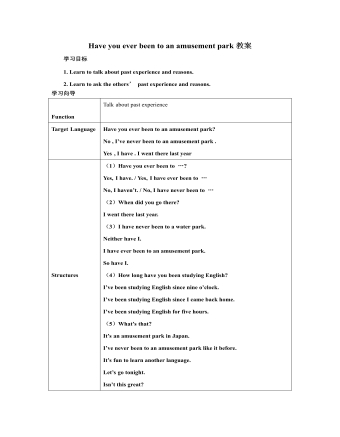
人教版新目标初中英语八年级下册Have you ever been to an amusement park教案
(1)Have you ever been to …? Yes, I have. / Yes, I have ever been to …No, I haven’t. / No, I have never been to …(2)When did you go there? I went there last year. (3)I have never been to a water park. Neither have I. I have ever been to an amusement park. So have I. (4)How long have you been studying English? I’ve been studying English since nine o’clock. I’ve been studying English since I came back home. I’ve been studying English for five hours. (5)What’s that? It’s an amusement park in Japan. I’ve never been to an amusement park like it before. It’s fun to learn another language. Let’s go tonight. Isn’t this great?space museum, amusement park, water park, South America, Peru, Holland, European culture, tour guide, flight attendant, musical instrument, more than, be from, get to, take lessons, neither, discover, graduate, change
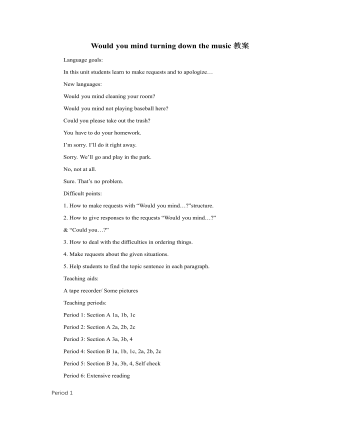
人教版新目标初中英语八年级下册Would you mind turning down the music教案
Step 4. Group work (4)1. Ask a pair of students to read the dialogue. Say, This activity provides speaking, listening and writing practice using the target language.2. Ask students to complete the work in groups.3. Check the answers with the whole class. 4. Explain some of the language points. Step 5. Word review (Self check 1)1. Ask students to read the words and the phrases given. 2. Fill in the blanks with proper forms of these words to complete the sentences. 3. Check the answers with the whole class. Homework:Do activity 2 on page 57 after class. Period 6Teaching aims: 1. Teach vocabulary words and the useful expressions. 2. Enable the students to learn etiquette in different culture. 3. Help the students learn how to behave politely in public places and in daily life. Teaching procedures:Step 1. RevisionHelp students to review the function of making requests through a free talk. Then lead them to the topic of etiquette. Explain the meaning of etiquette. Or, ask students to look it up in the dictionary. Step 2. Pre-reading (Section 1)1. Ask students to read the picture and make a list with their partner about how many rules of etiquette can be seen being broken.
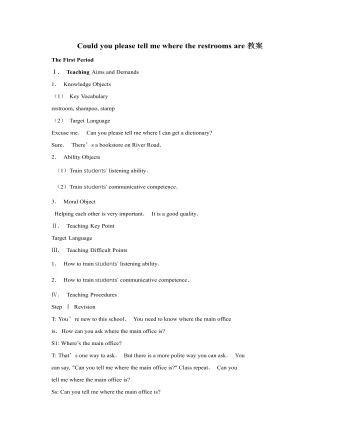
人教版新目标初中英语九年级下册Could you please tell me where the restrooms are教案
Step Ⅰ RevisionCheck homework. Ask a few students to read the article in 3a.Then ask a few students to read their guides.Step Ⅱ Part 1Look at the words in the box. Ask a student to read them. Make sure the students understand the meaning of the words. You are to fill in the blanks with the words. In some cases, students may need to use another form of the word, for example adjusting for tense or subject/ verb agreement.Ask students to fill in the blanks on their own.Check the answers. Step ⅢPart 2Go through the instructions with the class.Look at the example with the students.Ask students what the answer would be.Ask a student to read the question and answer it.Excuse me, could you tell me where the bank is, please?The bank is across the street from the shopping malt.Get students to complete the work in pairs.Check the answers. Ask a few students to read their questions.Step Ⅳ Just for Fun!Ask all the students to read the conversation. Ask: What is funny about this cartoon? Help students to explain. A Martian is a person from the planet Mars.There is no such thing as Martian food on Earth, and the clerk looks silly because he is trying to think of where there is a Martian restaurant.Invite some pairs of students to present this conversation to the rest of the class.Step Ⅴ Summary and HomeworkIn this class, we’ve done much writing practice using the key vocabulary words and the target language presented in this unit. After class, please finish the questions in 2 in your exercise books. Then finish the exercises on pages 47~48 of the workbook as well.The Seventh Period Ⅰ Teaching Aims and Demands1. Knowledge Objects(1) Key Vocabularyimage, adventure, jealousy, hero, crime, journey, brave, no longer, show interest in, take it easy, become interested in, plain looks(2)Text:Grown-ups like cartoons, too.2. Ability Objects(1) Fast-reading to get a general idea of the text.(2) Careful-reading to get the detailed information in the text.
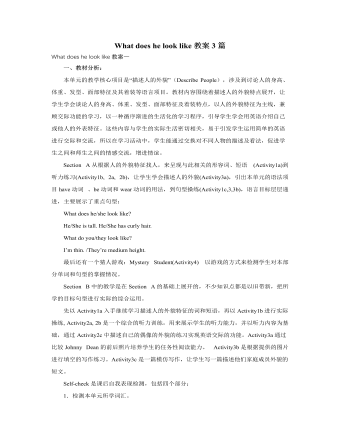
人教版新目标初中英语七年级下册What does he look like教案3篇
所需要用到的句子:Who is that?That is Jack. I like him.Why do you like him?I like him because he is interesting.Task 4: 设计理想中的人类Step one: 设计理想中的人类的外貌。把全班同学分成若干小组,学生可以边说边在纸上画出他们的模样。Step two: 设计理想中人类的性格。学生们可以把那些能描述性格的单词写在图画的旁边。Step three: 每组选出一名同学,其他同组同学提问,他作简单回答,并说明原因。所需用到的句子:What does he or she look like?He or she ...What is he or she like?He or she is ...Why?Because ...Task 5: 挑战性活动调查性格是天生的还是后天形成的,让每个同学回家去调查一下自己成长过程中性格是否有变化,具体是怎样的,为什么会这样? Teaching Aims:1. Enable students to have a general understanding of how to talk about people's physical appearance.2. Enable students to tackle some essential vocabularies and patterns about describing people. Provide them with necessary skills and methods.3. Create various chances for students to describe the persons they're familiar with, such as classmates, family members, teachers, idols, etc.
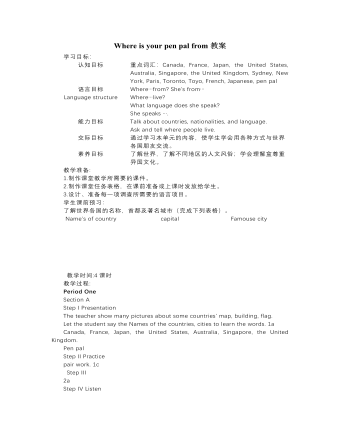
人教版新目标初中英语七年级下册Where is your pen pal from教案
2.1Match the country with the language.Step II Reading3a? let the students read the letter fast and answer the questions.? Let the students ask more questions about the letter as possible as the can.Step III Writing3b.Step IV. Pairwork2cStep V Listening2a, 2bStep V. HomeworkExercises book(1) P3Exercises book (2) P3Period FourStep I . Dictate the words and sentences in Unit1.Step II. Self-checkStep III. Check the answers for Exercises book in the unit.Step IV. Home workRevise and preparation for unit 2.教学反思:通过本单元的学习,学生基本可以谈论人们的国籍,居住城市及其所说的语言,通过书信方式去介绍自己并寻找笔友。但在涉及到国外的一些城市时,学生对这方面的知识相对欠缺,能介绍的城市并不多,也反应出学生课前预习不充分,这跟学生学习条件也有关,大多数学生无法通过网络获取所需信息。因此,在以后的教学中要多指导学生通过计算机网络获取信息,拓宽知识面。
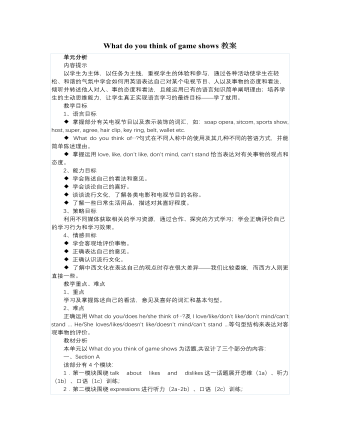
人教版新目标初中英语七年级下册What do you think of game shows教案
五、教学Section B-2c1. Pair work: What do you think of the belt/sunglasses/…? What does your father/mother/… think of your scarf/belt…?2. Group work(1). Teacher shows some different kinds of school uniforms (制服)and asks : “ What do you think of your school uniforms? If you have a chance to choose your school uniforms, what kind would you like to choose?”(2). Discuss in groups.(3).Get some Ss to report in class.说明:这一步旨在让学生运用已有的语言知识谈论对事物的看法和意见,并简单阐明理由,培养学生的主动思维能力和运用英语的能力。六、教学拓展调查电视节目的收视率任务:调查你周围的人对现在各种电视节目的反响。活动过程:1.教师布置任务,让学生调查周围的人(包括他的亲戚朋友和邻居)喜欢收看哪方面的电视节目。2.学生进行调查活动,运用本单元所学的句型What do you think of….? (Why?)What's your favorite game shows?What do you think of talk show?I doesn’t mind it.I like it.I love it.I can’t stand it.3.记录下排在前10位的TV Program,填写调查表,比较其收视率。
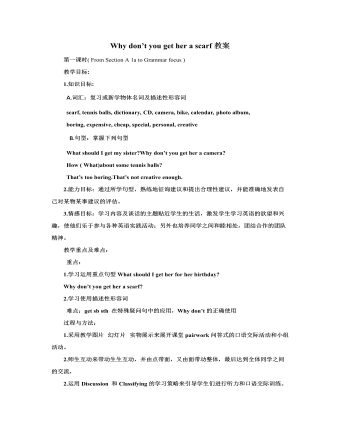
人教版新目标初中英语八年级下册Why don’t you get her a scarf教案
教师带领学生复习有关描述宠物的词汇,采用教师提问学生回答的方进行。如:T:What animals do you think would be good pets?What animals do you think would be bad pets?What do you think are good animals for a six-year-old child?然后学生进行 pairwork 练习。Task two: 师生互动,学习探究 1、播放3a部分的录音,引导学生一边听录音,一边跟读。2、通过听录音学生回答以下问题:Why do you think pot-bellied pigs are popular?What are the advantages and disadvantages of keeping such a pet?教师对学生的回答进行及时点评。3.学习范文,学习重点短语,为下步的模仿写作提供语言素材。T :1. )Have you ever kept a pig as a pet?Do you like pigs? St.:No.…Why don’t you like to keep a pig? St: No.They’re too dirty and lazy(Do you know in some foreign countries like Hollyland, Australia,pigs are the most popular pet.there’s a kind of pig.(图)it has an interesting name? it ‘s called a pot-bellied pig.) Now,let’s learn an article about this kind of interesting pet.2.)play the tapeSt.:Listen and repeat3.)show some Qs on computer(本子St.: read silently,then answerthe Qs(本子)4.)Ask ss. Close book and retell this passage.(what is a pot-bellied pig? Is it a good or bad pet? ) St.: retell it to each other“A pot –bellied pig is a popular pet now…”5.read the article together.St.:.practice reading
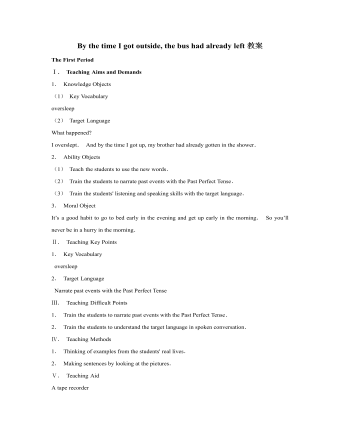
人教版新目标初中英语九年级下册By the time I got outside, the bus had already left教案
Ⅰ. Teaching Aims and Demands1. Knowledge Objects(1) Key Vocabularyoversleep(2) Target LanguageWhat happened?I overslept. And by the time I got up, my brother had already gotten in the shower.2. Ability Objects(1) Teach the students to use the new words.(2) Train the students to narrate past events with the Past Perfect Tense.(3) Train the students' listening and speaking skills with the target language.3. Moral ObjectIt’s a good habit to go to bed early in the evening and get up early in the morning. So you’ll never be in a hurry in the morning.Ⅱ. Teaching Key Points1. Key Vocabularyoversleep2. Target LanguageNarrate past events with the Past Perfect TenseⅢ. Teaching Difficult Points1. Train the students to narrate past events with the Past Perfect Tense.2. Train the students to understand the target language in spoken conversation.Ⅳ. Teaching Methods1. Thinking of examples from the students' real lives.2. Making sentences by looking at the pictures.Ⅴ. Teaching AidA tape recorderⅥ. Teaching ProceduresStep I Revision1. Revise the language points in Unit 8.Ask some questions like this: What volunteer work would you like to do?Help the students to answer, I’d like to…/I love to…/I hope to2. Practice the dialogue in Activity 3c on page 62 again. Get students to role play the similar dialogues with the following.

